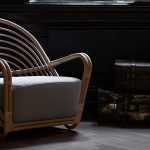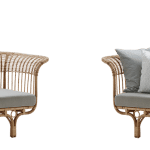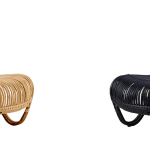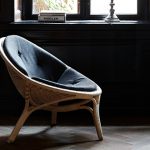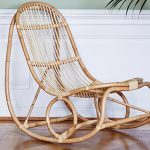
Wengler Chair
The Wengler chair is designed in 1902 by R. Wengler in his workshop in Copenhagen. The chair is an iconic classic and a display of the high quality craftmanship in Wenglers work with wicker furniture.
Viggo Boesen
Was trained as an architect, and in the 1930’s he was one of the architect’s, who introduced the new villa type in “Funkis-style” which was popular with a wider audience.
Together with Finn Juhl he furnished the first apartment on “Sortedamsdosseringen” in Copenhagen, where his easy chair made of rattan was displayed in the living room.
From his workshop he designed a number of pieces of rattan and upholstery furniture, which were constructed according to his philosophy. Furniture whould have an organic flow and embrace the body smoothly and tenderly. It should be a delight to the eye, but also be solid and durable.
Viggo Boesen designed a number of pieces of modernist profiled wicker furniture, which were based on the strength and durability of rattan.
Viggo Boesen’s FOX lounge chair won the design competition, that the Danish wicker-maker guild held in 1936. His inspiring, imaginative designs made him unique, and put him among the designers of the “Danish golden age”.
Sika-Design is proud to be the first to bring a Viggo Boesen design back into the market. FOX lounge chair is the first of many furniture pieces from this pioneer in organic furniture design.
Viggo Boesen is little known today but slowly his designs are becoming more and more known and popular around the world. His original furniture is being sold for unbelievable amounts in the worlds leading auction houses, in particularly his Little Petra.
FRANCO ALBINI BIOGRAPHY
- 1905 Born in Italy near Milan
- 1929 He obtains his diploma from Milan Polytechnic School
- 1930 He participated in the Monza Triennale where he showed his furniture designs
- 1936 At the Milan Triennale, Franco Albini presented progressive designs for a rational layout for small rooms
- 1941 He designs a transparent radio
- 1950 His designs for shelves and chairs is put in production by Cassina and Poggi
- 1951 He designs the rattan chair “Margherita”
- 1951 He designs the Belladonna sofa in rattan, that is now produced by Sika-Design
- 1952 Franca Helg and Franco Albini becomes business partners. Franca plays a crucial role in a numerous of the designs by Franco Albini
- 1957 He designed the building for the LA Rinascente department store in Rome
- 1963-1977 He, Helg and Bob Noorda collaborated on a project to design several stations within the Milan subway system
- 1977 Franco Albini dies
NANNA DITZEL BIOGRAPHY
- 1923 Born in Copenhagen, Denmark
- 1943 Educated as a cabinetmaker
- 1945 Awarded Second Prize in Cabinetmaker’s Guild Exhibition together with her husband
- 1946 Graduates from Industrial Arts and Crafts College, Copenhagen
- 1946 Establishes own design studio together with Jørgen Ditzel
- 1947 Wins prizes in 8 different competitions (glass, textiles, furniture & ceramics)
- 1950 Nanna & Jørgen Ditzel began to work with wicker in cooperation with the renowned wicker worker R. Wengler in Copenhagen
- 1951 Designs the Rana Chair and the Madame Chair
- 1959 Designs the Hanging Egg Chair
- 1961 Nanna Ditzels husband, Jørgen, dies
- 1961 Designs the Chill Chair
- 1964 Designs the furnishing fabric, Hallingdal
- 1968 Moves to london
- 1969 Deisgns the Nanna Rocking Chair
- 1970 Establishes her own studio in London
- 1986 Returns to denmark and opens a combined design studio and furniture workshop in Copenhagen
- 1995 Elected Knight of the Order of Dannebrog
- 2000 Awarded the Danish Design Prize
- 2005 The death of Nanna Ditzel in Copenhagen
ARNE JACOBSEN BIOGRAPHY
- 1902 Born in Copenhagen
- 1924 Enrols as an architecture student at the Royal Academy of the Arts in Copenhagen
- 1925 Wins a silver medal for a the Paris Chair at the Exposition Internationale des Arts Décoratifs in Paris where he discovers Le Corbusier’s work
- 1927 Visits Berlin where he sees the architecture of Walter Gropius and Ludwig Mies Van Der Rohe. Wins a gold medal on graduating from the Royal Academy
- 1930 After years of designing private houses as a young architect, Jacobsen wins his first public project to modernise the beach at Bellevue
- 1935 Completes the groundbreaking Bellavista apartment blocks, now regarded as a classic of the Danish modern movement, in Klampenborg
- 1935 Designs the controversial Stelling Hus building in Copenhagen
- 1943 Begins two years of wartime exile in Sweden where he concentrates on textile and wallpaper design and a summer house for two doctors
- 1945 Returns to Denmark in peacetime to spend several years working on housing and schools.
- 1950 Starts a five year project to design the Søholm series of houses in Klampenborg, which mark the start of a looser, more experimental phase.
- 1951 Inspired by Charles and Ray Eames’ furniture, Jacobsen designs the moulded plywood Ant Chair, later refined into
- 1955’s best-selling Series 7.
- 1956 Designs two upholstered chairs – the Egg and Swan – for the SAS Royal Hotel in Copenhagen as well as the stainless steel cutlery later chosen by Stanley Kubrick as a prop in 2001: A Space Odyssey.
- 1960 Wins the commission to design St Catherine’s College, Oxford. He insists on designing the fixtures, fittings and garden as well as the buildings.
- 1961 SAS Royal Hotel opens in Copenhagen as the apogee of Jacobsen’s ambition to design a building in its entirety down to the smallest fixtures.
- 1964 The futuristic Belvedere Restaurant opens in Hannover above an early 18th century garden. Jacobsen begins a three year collaboration with Stelton, run by his foster son Peter Holmblad, on the Cylinda Line cocktail kit
- 1966 Jacobsen wins the competition to design the new National Bank of Denmark headquarters in Copenhagen. Construction continues after his death with the building opening in 1978.
- 1971 Arne Jacobsen dies in Copenhagen
